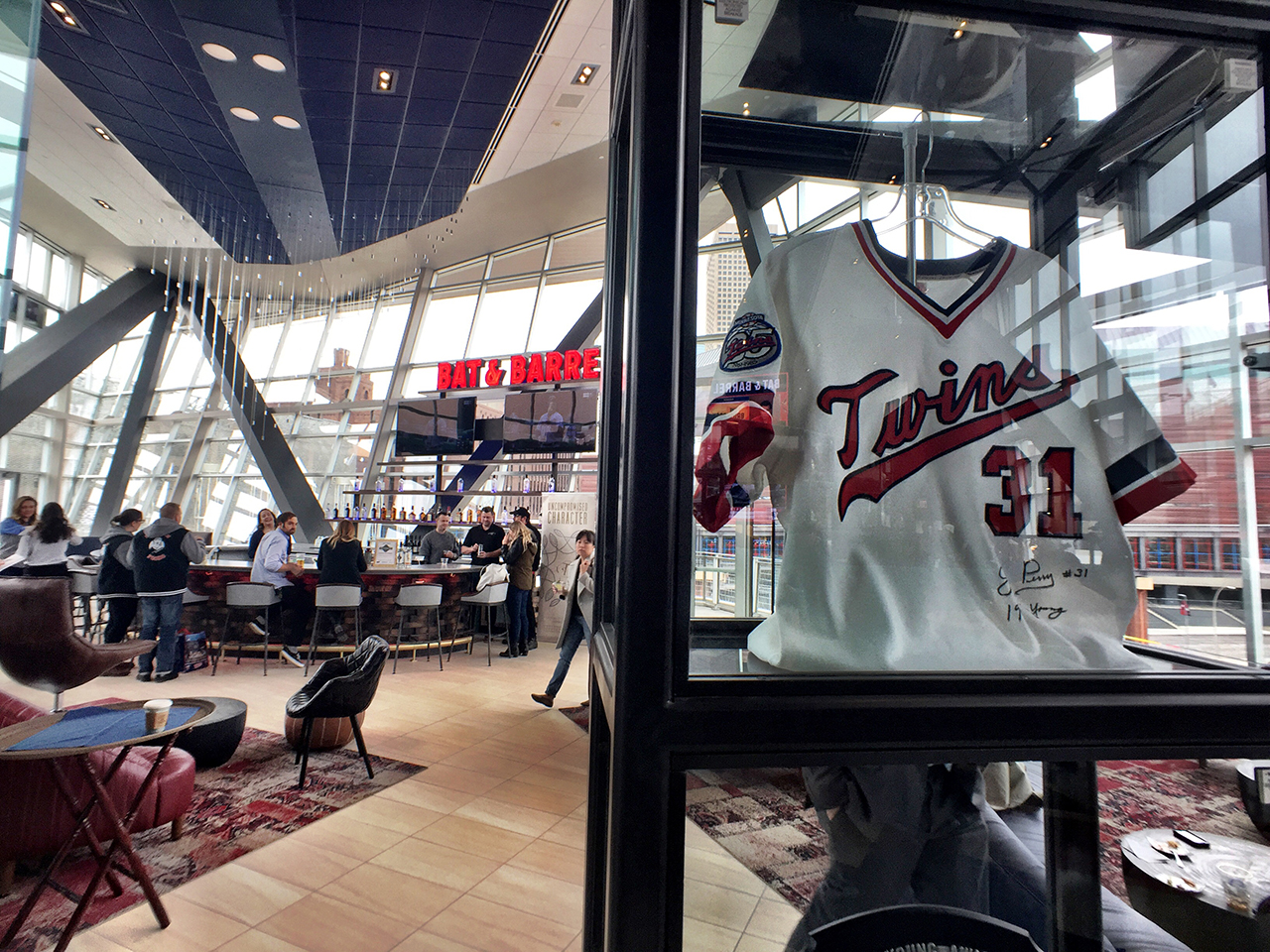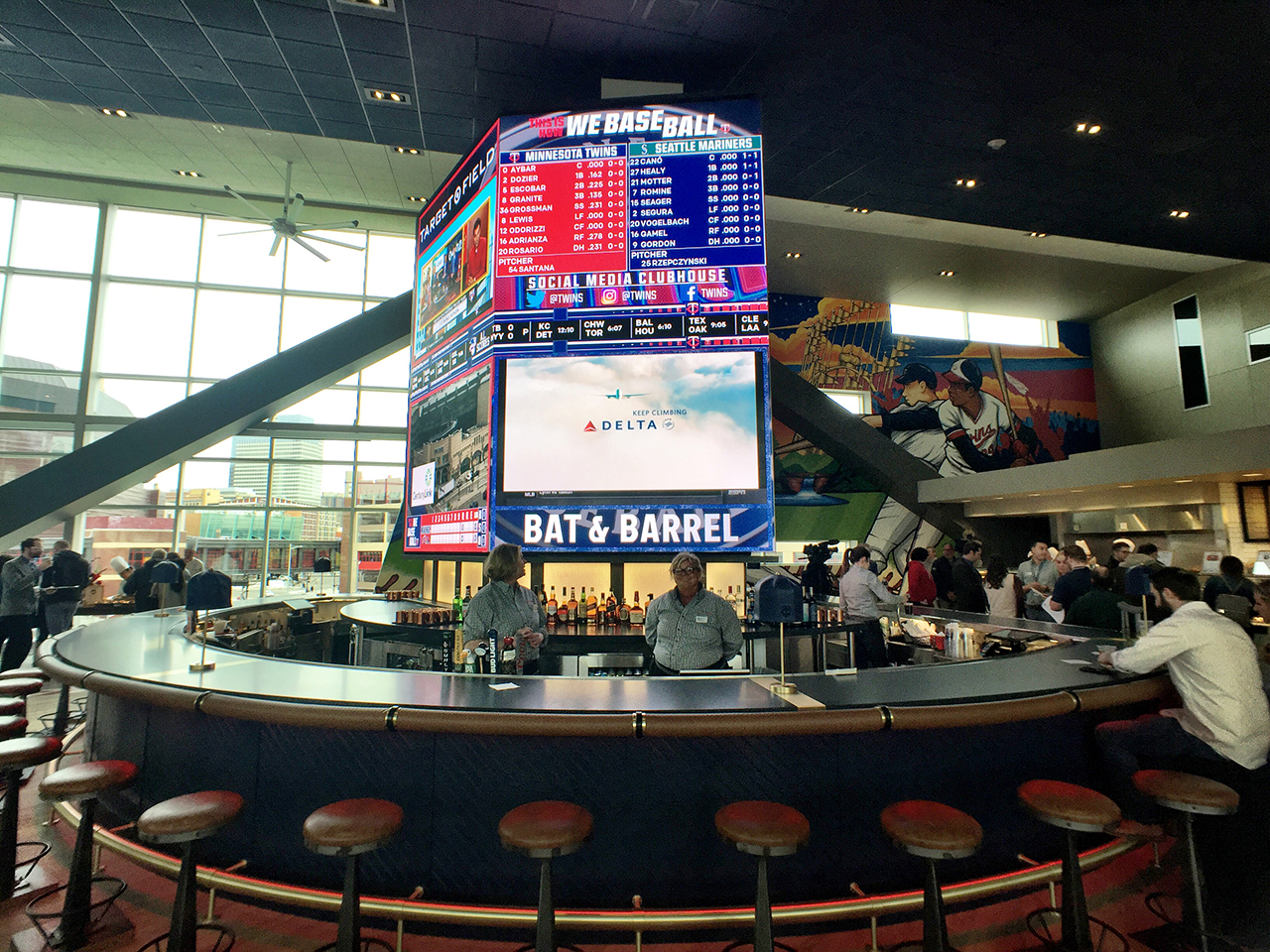The Minnesota Twins certainly are not afraid to change things up at Target Field. The opening of the unique Bat & Barrel social space/sports bar elevated the game-day fan experience, earning it the 2018 Ballpark Digest Award for Best Renovation (MLB).
Social spaces are popping up all throughout baseball: the New York Yankees added one to Yankee Stadium in 2017 and the Miami Marlins are adding two to Marlins Park in 2019. With Bat & Barrel, as well as an overhaul of concessions in the right-field corner of Target Field, the Minnesota Twins added another social space to a ballpark that’s already extremely social, while upgrading an underused space: the high-end Metropolitan Club, limited to season-ticket holders.
“In 2016 we started to reimage what that corner of the ballpark could be,” said Twins President and Chief Executive Officer Dave St. Peter. “The metrics showed it was being underutilized, and we were not getting the usage we thought the space deserved.” The Metropolitan Club was designed as a tribute to the team’s original home, Metropolitan Stadium, with displays highlighting team history and the arrival of the Twins in 1961.
“After surveying season-ticket holders, we found out it was too closed off from the game experience,” St. Peter said. “With that, it informed an idea about a new space with vertical accessibility.”
Gone were the sealed windows overlooking the playing field, replaced by openable windows. Gone was the formal seating, replaced by a much more open space featuring two bars, plenty of casual seating and a new concessions area with its own menu. A casual bar featured high-end artisan cocktails developed with local vendors like Tattersall Distilling. A larger bar sports high-def displays, focusing on game action and other sports news of the day. An upgraded audio system allowed for plenty of live music before and after games.
Tying the room together: plenty of memorabilia, including Gold Glove and Silver Slugger awards, as well as jerseys and other items highlighting Twins history. The work of local artists gives the space plenty of color, and the addition of a stairway leading down to the right-field corner allows plenty of casual access.
During the season, you’d see plenty of folks moving in and out of the space, many for an inning or three. It certainly was a hot spot and attracted a prime sports-going demographic: millennials who don’t spend nine innings glued to their seats.
Adding a second entrance allowed the Twins to reconfigure the right-field corner with new concessions, including a craft-beer stand, Draft 34, featuring a brew developed by former Twins closer and Minnesota native Glen Perkins, in association with Surly Brewing. Permanent concession stands were installed nearby, including a stand featuring sausages from local favorite Kramarczuk’s. Traditionally, this area has been a bottleneck for fans working their way in and out of the ballpark, as well as those navigating the 360-degree concourse.
“The changes made for a better ingress-egress experience,” St. Peter said. “It’s more aesthetically pleasing and more fan-friendly.”
The Importance of Design
The look came from Minneapolis’s Shea Design, working with the Twins and ballpark architect Populous.
“The results speak for themselves,” St. Peter said. “By making it open for all fans, it was a much more active space and much more of a destination in the ballpark than it was.
“I think Bat & Barrel has been spectacular,” he added. “Certainly, all our research has shown younger customers aren’t looking for a fixed seat, but a shared experience with friends. But Bat & Barrel has the ability to cater to different fans. There’s a lively pregame atmosphere with season-ticket holders as well.”
One other distinguishing factor that makes the Bat & Barrel noteworthy in the context of our awards: the design certainly stands on its own. Yes, it’s a sports-centric space, but it’s a high-end space with plenty of high-end finishes. The emphasis on design is no accident, St. Peter says.
“I think design is critically important, and one of our primary filters is aesthetics,” he said. “The Pohlad family has set a standard for how this ballpark looks, how it represents Minneapolis and the state of Minnesota.
“Yes, functionality is also critical. But it’s not necessarily where we start. Often we start with aesthetics and then it goes into other areas.”
Looking to 2019
The changes at Target Field will continue in 2019, with the Twins extending Gate 34 closer to First Avenue and creating a new plaza. New security gates, concessions and more will add to the game-day experience. Overall, 9,500 square feet of “new” space will be added within the security perimeter.
Again, the goal is to create another space where fans can hang out before, during and after a Twins game. Within that new space there will be 5,100 square feet of turf, designed for kids to burn off some energy during a game. A 2,500-square-foot market will feature a flexible interior space with a mix of food and specialty items, including vendors you would not normally see at the ballpark. And, of course, you’ll see additional points of sale. By extending the security perimeter, the new space could become a destination during the game and a natural selfie spot, given the number of statues of Twins greats located there.
For the Twins, adding new features is a tool to keep fans coming to games in one of the most competitive sports markets in the country. In the last decade or so we’ve seen a number of high-end venues open in Twin Cities, including U.S. Bank Stadium and CHS Field, with Target Center undergoing a significant renovation for the 2017-2018 season and Allianz Field, the new home of MLS’s Minnesota United, opening in 2019. (In a triumph of urban planning, every one of these venues, as well as University of Minnesota athletic facilities like Williams Arena, is served by Green Line light rail.)
“It’s a great time to be a sports fan in Minnesota,” St. Peter said. “Owners and executives are motivated to find ways to ensure relevance not just with their team, but with their facilities. We all are looking for ways for our facilities to stand out.
“We are encouraged to try things differently,” he added. “We think we have a wonderful game-day experience, but we’re not naïve—things need to evolve, and we recognize that.”
Past Ballpark Digest Renovation of the Year winners:
2018 Best Ballpark Renovation (MiLB/College): Franklin Rogers Park, Mankato MoonDogs
2017 Best Ballpark Renovation (MLB): George M. Steinbrenner Field
2017 Best Ballpark Renovation (MiLB): Flour Field
2016 Renovation of the Year: The Outfield Apartments, Lansing Lugnuts
2015 Best Major Ballpark Renovation: CenturyLink Sports Complex/Hammond Stadium
2015 Best Ballpark Renovation Award (Over $6M/Under $20M): AutoZone Park
2015 Best Ballpark Renovation Award (Under $6M): Dr Pepper Ballpark
2014 Best Ballpark Renovation Over $2M: Durham Bulls Athletic Park
2014 Best Ballpark Renovation Under $2M: Simmons Field
2013 Best Ballpark Renovation Under $1M: Centennial Field, Modern Woodmen Park
2013 Best Ballpark Renovation Over $1M LECOM Park (McKechnie Field)
2012 Ballpark Renovation of the Year: Four Winds Field (Coveleski Stadium)
2011 Ballpark Renovation of the Year (Over $10M): Cheney Stadium
2011 Ballpark Renovation of the Year (Under $10M): Warner Park
2010 Ballpark Renovation of the Year: Metro Bank Park
2018 Ballpark Digest Award Winners
Best Ballpark Improvement Over $1M: GCU Ballpark
2018 Best Ballpark Renovation (MiLB/College): Franklin Rogers Park, Mankato MoonDogs
Organization of the Year: Elmore Sports Group
Best Ballpark Improvement Under $1M: Round Rock Express
Editor’s Choice: Ivy at Berlin Place
Best New Logo/Branding: 2018 Best New Logo/Branding: Copa de La Diversión
Marketing Campaign: Omaha Storm Chasers
Marketing TV Spot: Quad Cities River Bandits
Continued Excellence Award: Fort Wayne TinCaps
Promotion of the Year: Deaf Awareness Night, Myrtle Beach Pelicans
MLB Broadcaster of the Year: Pat Hughes
MiLB Broadcaster of the Year: Tim Heiman
Commitment to Charity: Hartford Yard Goats
Team of the Year: Indianapolis Indians
Executive of the Year: Doug Scopel
Ballpark of the Year: SRP Park





